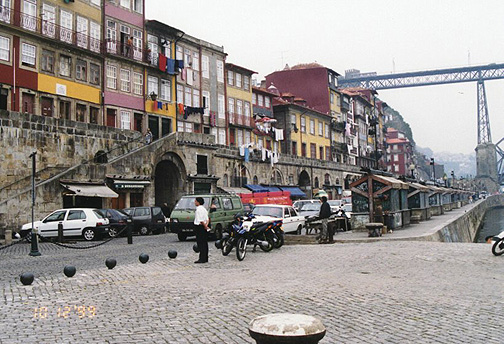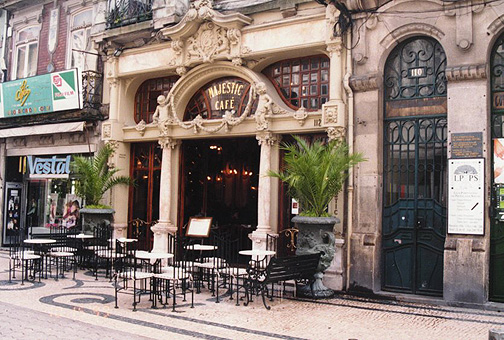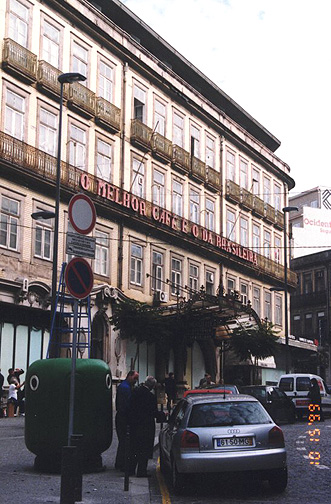

Porto, Portugal

Old town (under the bridge)
Main Events Chronology 218 bC The Romans arrived at Iberia 409 AD Alans, Vandals and Suebi invade the North 416 The Visigoths entered Iberia 711 Muslims are in Spain 716 Minho and Galicia take part in the Muslim government 868 Christian Reconquest of Oporto 1073 Afonso VI is the Spanish Emperor and governs Galicia, Oporto and Coimbra 1095 Henrique of Burgundy started ruling the lands in the South of River Minho, including Oporto area 1095-096 Constitution of the Portucalense County 1113 D. Hugo is the bishop of Oporto
1113/1136 Foundation of the Cathedral, "Se", of Oporto 1115 Bull Egregias quondam sent by Pope Pascoal II locating the diocese of Oporto in the straight dependence from the Holly See 1120 Regina Teresa makes the donation of the town and lands to the bishop D. Hugo and his successors 1123 The bishop D. Hugo delivered a bill of privileges to Oporto and to its inhabitants 1128 Afonso Henriques, son of Teresa and Henrique of Burgundy, grand son of the late Emperor Monso VI and cousin of the new Emperor Afonso VII, is the new governor of the Portucalense County 1139 Afonso Henriques is Afonso I, king of Portugal 1179 The Holy See confirms the title of king of Portugal to Alonso I and Portugal as an independent kingdom 1208 Revolution in Oporto 1258 There was already an important market in Oporto 1290 Establishment of a trade stock exchange for merchants 1293 Oporto is officially present in the Trade Stock Exchange 1297 There was an important Jewish community in Oporto 1309/1310 The merchants in Oporto who traveled to Flanders had important privileges
Town hall in Modern town
1315 Establishment of the Order of Christ 1339/1348 Inquiries concerning the city of Oporto 1341 The Portuguese population prepares the navigation towards the Canary Is. 1345 King Dom Monso IV took the jurisdiction of the city of Oporto, which belonged to the bishop since 1120 Dom Pedro, bishop of Oporto, interdicts the diocese when the king took its jurisdiction to him 1348 The Black Plague extends over Portugal 1353 Oporto is present in the Treaty celebrated between Portugal and England 1366 The walls of Oporto (as a fort) began being built 1369/1384 Enlargement of Oporto outskirts 1370/1380 Creation of the Maritime Insurance Stock Trade 1372 Reunion of sessions of the Parliament (Cortes) in Oporto 1385 The first "Casa da Moeda" (Mint) of Oporto started functioning, with a mint-master
1387 Dom Jodo I marries to Filipa of Lancaster in Oporto
1392 Artisans in Oporto are present in the Town Hall sessions
1394 Prince Hetuy, The Navigator was born in Oporto
1406 Oporto that was patrimony of the bishop, finally, began
belonging to the king of Portugal
1415 A vessel left from Oporto to the conquest of Ceuta
1437 The Northern population prepares the attack to Tangier
1466 Leo von Rosmital crossed a bridge over River Douro, in Oporto, in his tour through Portugal

Majestic Cafe (Tea House)
1475 Artisans in Oporto are present in the Town Hall sessions
1494 Scientists from Oporto takes part in the Tordesillas Treaty
1497 Oporto prepares to the expedition to India, led by Vasco da Gama
1500 Oporto takes part in the official discovery of Brazil, led by Pedro kvares Cabral
1520 Oporto takes part in the preparation of the navigation from Angola to Cape of Good Hope
1527/1532 The census considers Oporto the second most important city in Portugal
1680 Development of the exportation of Port Wine to England
train station
1725 Nicolau Nasoni starts the paintings of the Chancel of the "S6" in Oporto
1730 Nicolau Nasoni presents the first project of the Church of the "Cle'rigos" (Clergies) and lays the foundation-stone (opened in 1748; its famous tower was build between 1748 and 1763)
1734 Nicolau Nasoni makes the drawing of the Episcopal Palace in Oporto
1745 Nicolau Nasoni makes the paintings for the high altar of Saint Ildefonso Church, in Oporto
1748 The 1st newspaper in published in Oporto, the "Zodiaco Lusitano"
1754 Beginning of the construction of the Torre dos Cldrigos, by Nicolau Nasoni
Green Wine Institute
interior
1756 Establishment of the General Company of the Agriculture of Vineyards in Alto Douro
1758 Popular reaction against several privileges of the Agrarian Company of the wines in Alto Douro
1762 Establishment of the Royal Nautical School of Oporto
1776 Bill restricting the monopoly of the Port Wine Company
1780 Establishment of the "Aula de desenho e Debuxo", School of Drawing and Design in Oporto
1791 The Corporative Organizations were abolished
central Porto
1792 Foundation of the "Casa Pia" in Oporto
1794 Pinto de Miranda shows the drawing and plans of the Church
of the Order Terceira of Saint Frances in Oporto
1795/1809 Construction of the Palace of Carrancas in Oporto
1820 The Liberal Revolution
1850 The Industrial School was established
And the Polytechnic Academy
1876 Eiffel directs the construction of the Bridge D. Luis
1877 Train Connection between Lisbon and Oporto
1880 1st wine-growing exhibition
1881 1st Exhibition of Jewelry and Pottery Manufactures
1884-1892 The Portuguese government gave the first indications to build the artificial port of Leix6es to
serve Oporto and its hinterland 1889 To develop the agriculture, it has been established the Northern Agrarian League
flowers at the grave site
1891 The 1st Republican Revolution
1st Exhibition of Industrial and Technical Schools
1903 Agrarian Exhibition in Oporto Crystal Palace
1906 Republicans and Monarchists start governing together Foundation of Oporto Foot-ball Club
1908 Dom Manuel 11, King of Portugal, visited Oporto
1909 The Anticlerical Demonstration in Oporto was not so strong
and evident as it was in Lisbon

Once popular Brazil cafe
1911 1st attempt to restore the Monarchy
Establishment of the University, gathering the Polytechnic Academy, the Medical School and the Pharmacy School, too
1919 The Monarchy was proclaimed again
1923 Opening of the cafeteria "Majestic" in Oporto, the first one for ladies too
1925/1926 In Oporto, the foundation of the Military Dictatorship
took place, to establish the so-called "Estado Novo"
trolley
(was main transportation. Now for tourists)
1927 Rebellion against the Military Dictatorship started in Oporto: insurrection to deliver the power to Salazar
1932 Salazar was Prime Minister, which he added to Minister of the Exchequer
1947 Rebellion to discharge Salazar, without success
1963 Inauguration of the Bridge of Arrdbida over River Douro
1994 Opening of the House of Prince Henry, with an exhibition
2004 Oporto is the European Capital of the Culture
bored students waiting for the bus
![]()
Return to Elderhostel in Portugal page
Return to Portugal Country page
![]()